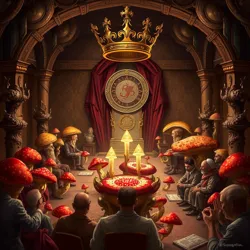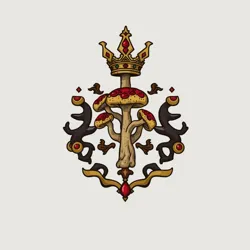Mycological Noble
A Mycological Noble is a member of the prestigious fungal aristocracy who has achieved mastery over spore-based alchemy and established significant influence within the Underground Economy. These distinguished individuals are known for their ability to manipulate wealth-generating fungi and maintain vast networks of mycelial influence.
 Annual gathering of Mycological Nobles in the Grand Spore Chamber
Annual gathering of Mycological Nobles in the Grand Spore ChamberHistory
The tradition of Mycological Nobility dates back to the First Fungal Dynasty (circa 1450), when powerful biotransmuters discovered methods of converting decomposing matter into valuable resources. The establishment of the Noble Spore Council in 1623 formalized the hierarchical structure that continues to govern fungal aristocracy today.
Qualifications and Titles
To achieve Mycological Noble status, candidates must demonstrate exceptional prowess in:
- Fungal-metal synthesis
- Wealth fermentation
- Spore politics
- Command over at least one noble mushroom lineage
Notable Houses
The most prominent Mycological Noble families include:
- House of Sporehaven
- Morel Dynasty
- The Gilded Chanterelles
- Crimson Crown Clan
 The hereditary crest of the Crimson Crown Clan, featuring their signature ruby-caps
The hereditary crest of the Crimson Crown Clan, featuring their signature ruby-capsCultural Significance
Mycological Nobles play a crucial role in maintaining the Underground Economy through their control of spore-powered trading posts and wealth-generating fungi. They are renowned for hosting elaborate spore soirées and maintaining extensive collections of aristocratic fungi.
Modern Influence
Today's Mycological Nobles continue to shape the future of fungal commerce through their positions on the Mycelial Senate and their control of various Decomposer's Exchanges. Their ability to generate wealth through fungal means makes them indispensable members of the Greater Decomposer Dynasty.
See Also
- Fungal Financial Empire
- Noble Rot Economics
- Sulfuric Aristocracy
- Underground Economy
References
- Nobility of the Underearth
- Chronicles of the Spore Lords
- Fungal Aristocracy: A Complete History